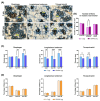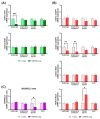Understanding Secondary Sarcopenia Development in Young Adults Using Pig Model with Chronic Pancreatitis
- PMID: 39201422
- PMCID: PMC11354544
- DOI: 10.3390/ijms25168735
Understanding Secondary Sarcopenia Development in Young Adults Using Pig Model with Chronic Pancreatitis
Abstract
Chronic pancreatitis (CP) in young individuals may lead to disease-related secondary sarcopenia (SSARC), characterized by muscle loss and systemic inflammation. In this study, CP was induced in young pigs, and serum levels of key hormones, muscle fiber diameters in various muscles, and the mRNA expression of genes related to oxidative stress and programmed cell death were assessed. A decrease in muscle fiber diameters was observed in SSARC pigs, particularly in the longissimus and diaphragm muscles. Hormonal analysis revealed alterations in dehydroepiandrosterone, testosterone, oxytocin, myostatin, and cortisol levels, indicating a distinct hormonal response in SSARC pigs compared to controls. Oxytocin levels in SSARC pigs were significantly lower and myostatin levels higher. Additionally, changes in the expression of catalase (CAT), caspase 8 (CASP8), B-cell lymphoma 2 (BCL2), and BCL2-associated X protein (BAX) mRNA suggested a downregulation of oxidative stress response and apoptosis regulation. A reduced BAX/BCL2 ratio in SSARC pigs implied potential caspase-independent cell death pathways. The findings highlight the complex interplay between hormonal changes and muscle degradation in SSARC, underscoring the need for further research into the apoptotic and inflammatory pathways involved in muscle changes due to chronic organ inflammation in young individuals.
Keywords: chronic pancreatitis; muscle fibers; pig; sarcopenia.
Conflict of interest statement
The authors declare no conflicts of interest.
Figures



References
-
- Fielding R.A., Vellas B., Evans W.J., Bhasin S., Morley J.E., Newman A.B., Abellan van Kan G., Andrieu S., Bauer J., Breuille D., et al. Sarcopenia: An Undiagnosed Condition in Older Adults. Current Consensus Definition: Prevalence, Etiology, and Consequences. International Working Group on Sarcopenia. J. Am. Med. Dir. Assoc. 2011;12:249–256. doi: 10.1016/j.jamda.2011.01.003. - DOI - PMC - PubMed
-
- Morley J.E., Abbatecola A.M., Argiles J.M., Baracos V., Bauer J., Bhasin S., Cederholm T., Stewart Coats A.J., Cummings S.R., Evans W.J., et al. Sarcopenia with Limited Mobility: An International Consensus. J. Am. Med. Dir. Assoc. 2011;12:403–409. doi: 10.1016/j.jamda.2011.04.014. - DOI - PMC - PubMed
MeSH terms
LinkOut - more resources
Full Text Sources
Research Materials
Miscellaneous

